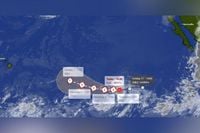On September 2, 2025, a new force began to swirl in the eastern Pacific: Hurricane Kiko. According to the U.S. National Hurricane Center (NHC) in Miami, Kiko formed far out at sea, roughly 1,840 miles east of Hawaii, and immediately drew the attention of meteorologists across the Pacific basin. While Kiko posed no immediate threat to land, its steady intensification and westward march have made it a storm to watch closely in the days ahead.
Kiko’s rapid development has been marked by a series of notable milestones. By the morning of September 2, the system’s maximum sustained winds had climbed to near 85 mph (140 km/h), with higher gusts, as reported by the NHC and local outlets like BIVN. The storm was moving west at about 7 mph (11 kph), a pace expected to continue for the next couple of days. The NHC’s forecast called for Kiko to strengthen steadily, with the potential to reach major hurricane status—defined as Category 3 or higher—by the night of September 3.
“Kiko is over very warm water right now and it is expected to become a Category 2 hurricane by tomorrow morning, although it’s possible it could get there later today. Due to the very warm water, it cannot be ruled out that the hurricane could reach major hurricane status over the next few days,” AccuWeather lead hurricane expert Alex DaSilva told Newsweek. The NHC echoed this outlook, noting that Kiko should remain over sea-surface temperatures of 27-28°C for the next 48 hours, with only light to moderate easterly wind shear—conditions favorable for further intensification.
Satellite imagery has provided a window into Kiko’s intensification. The NHC’s 5 a.m. HST discussion described the hurricane’s eye as “apparent on nighttime visible imagery,” with the small cyclone “clearly intensifying.” Dvorak estimates—a key tool for assessing hurricane strength—ranged from 77 to 90 knots, while other objective estimates hovered in the 60-74 knot range. The official initial intensity was set at 75 knots (about 85 mph), representing an average of these measurements.
Despite its growing strength, Kiko remains a distant threat. As of September 2, the NHC had not issued any coastal watches or warnings. Hurricane-force winds extended outward up to 15 miles from Kiko’s center, with tropical-storm-force winds reaching up to 60 miles. The storm’s slow westward motion is being steered by a subtropical ridge to the north, a common atmospheric feature that guides many Pacific hurricanes away from land in their early stages.
But will Kiko eventually threaten Hawaii? That’s the question on many minds. The NHC and the National Weather Service in Honolulu both noted that it was “too early to tell what, if any, impacts this system might have on local weather as it nears the islands early next week.” Forecast models showed Kiko continuing its westward journey for a couple more days, with a gradual turn toward the west-northwest expected by September 5 or 6 as an upper-level trough north of Hawaii begins to erode the subtropical ridge. By that time, Kiko is expected to cross into the Central Pacific basin—defined as 140°W longitude—on Friday or Saturday.
Some weakening is anticipated as Kiko approaches cooler waters and drier air near Hawaii in four to five days. The NHC’s updated forecast calls for a peak intensity of 100 knots (about 115 mph) before gradual weakening begins, but the storm is expected to remain at hurricane strength through day five. “As the storm approaches the islands, it will move over cooler water, which should help to reduce the wind intensity of the storm,” DaSilva explained to Newsweek. “Regardless, we urge everyone with interests in Hawaii to follow the AccuWeather forecast very closely as small shifts in track can have major implications of the direct impacts felt on the islands.”
It’s worth noting that the 2025 eastern Pacific hurricane season, which runs through November 30, has already seen several named systems, including Barbara, Flossie, Iona, and Henriette. The National Oceanic and Atmospheric Administration (NOAA) had previously predicted a below-normal season for the region, with an expectation of 12 to 18 named storms, five to ten hurricanes, and two to five major hurricanes. Kiko’s intensification—potentially to major hurricane status—serves as a reminder that even a below-average season can produce powerful storms.
While Kiko commands attention, meteorologists are also monitoring other systems. Tropical Depression Twelve-E, located east of Kiko, was expected to strengthen later on September 2, bringing heavy rainfall to parts of northwestern Mexico from Colima to Sinaloa. The NHC warned of a risk of isolated flash flooding in mountainous areas, with rain bands forecast to reach Baja California Sur by September 3 and possibly persist through September 6. Rainfall totals of four to eight inches are possible, though they may vary depending on the storm’s track and intensity.
Meanwhile, over in the Atlantic, a tropical wave south of the Cabo Verde islands is under close watch. The NHC gave this disturbance a 60 percent chance of cyclone formation within seven days—a notable increase from the 40 percent probability reported the previous day. If it develops, it would become Tropical Storm Gabrielle, the seventh named storm of the Atlantic season.
As for Kiko, the lessons of past Pacific hurricanes loom large. Hawaii has seen its share of close calls and direct hits, from Hurricane Iniki in 1992 to more recent near-misses. With Kiko’s path and intensity still subject to change, meteorologists caution that “there is still a lot of time to watch Kiko,” as DaSilva put it. “It is certainly possible that the storm could trend north or south of the [Hawaiian] islands and bring little to no direct impacts. There is also the possibility that the storm could bring rain and wind impacts to the islands.”
For now, the NHC continues to issue regular updates on Kiko’s progress via its website and social media channels. With the storm’s projected strengthening and westward drift, residents and travelers throughout the Central Pacific are advised to stay tuned—and to remember that hurricane season is far from over.
As Kiko churns across the Pacific, it serves as a potent reminder of the unpredictable power of nature and the importance of vigilance, even in a season forecast to be quieter than usual.


